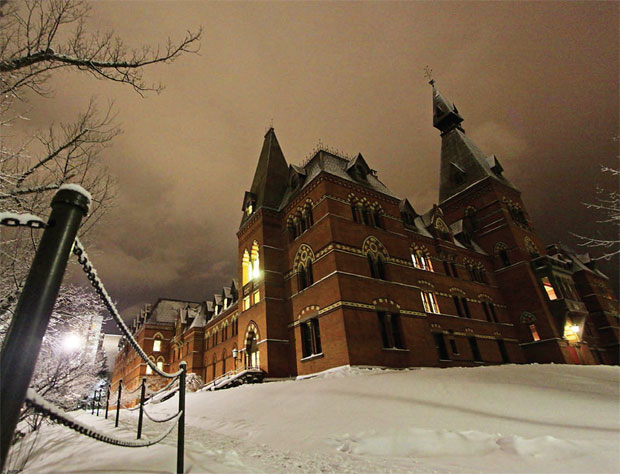
Photo by Matt Hintsa ’10
After the vast exodus from the Hill in the middle weeks of December, after Christmas and New Year’s have come and gone, January arrives in Ithaca. Each day adds a minute or so of pale, slender light to the very short hours of sun. Winter—the real, the legendary, Ithaca winter—has set down its deep, tough roots.
Ithaca is similar to such sun-kissed cities as Los Angeles and Las Vegas in one odd yet important respect: many—if not most—of its residents come from somewhere else. So during the early weeks of the New Year, Ithaca turns into a very different kind of place.
It’s a little like Muscovites have fled Napoleon’s army—or in this case, rushed away from the shortest, darkest days of the year in a city not celebrated for its blue skies and sunlight. Dead and dry Christmas trees, tinsel still strewn in their branches and fluttering in the wind, appear like fallen soldiers on the lawns around town, awaiting pickup by the city’s sanitation crews.
Yet for those of us who remain, something quite beautiful appears on campus and in the city—something hushed and etched and sparkling, something that might almost be called holy. Ithaca becomes a small, sleepy, simple town.
On Tower Road and on the Arts Quad, on freezing January nights, minutes and even hours can go by without a single car passing or a bundled-against-the-cold walker moving silently by. The lights in the clock tower remain on, and seem especially sharp and clear in the dark, icy air.
In some of downtown’s sleepier neighborhoods, if a light snow has fallen a slow hour can pass before a single set of tire tracks appears. Some houses, of course, remain lit, and some still have Christmas lights frosting their porches or lights glowing like candles in windows. Through a few front windows, on Buffalo Street and Cayuga Street, wood stoves and fireplaces blaze behind gauzy curtains, and there is the smell of smoke in the cold air.
On the other side of town, on the far eastern edge of campus, almost nothing but a slight, freezing breeze stirs the Plantations’ Newman Arboretum. But near the pond, two, three, four, maybe five deer emerge from a cluster of trees. They move noiselessly, searching for food—maybe, like the rest of us, seeking even a slim minute more of light.
Just as silently, they disappear into shadows, into an even deeper darkness and silence. And everything everywhere is hushed.


